Number of Marawi ‘bakwits’ surpass city population
The number of internally displaced persons in Marawi City has exceeded the actual number of residents in the local government unit.
The two-week-long battle between the Maute Group and government forces left almost 240,000 “bakwits” or internally displaced persons as of June 6, data from the Autonomous Region in Muslim Mindanao Crisis Management Committee show.
This is more than the latest figure on residential population of the city, which stood at 201,785 persons based on the latest Census of Population in Housing in 2015.
The discrepancy between the census population and the number of IDPs can be attributed to a big transient population—city workers who are not permanent residents of the city or students studying at Mindanao State University.
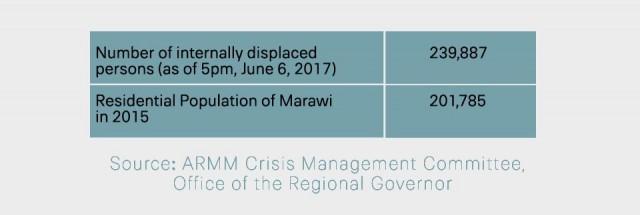
Marawi City is the only highly urbanized city in ARMM and has a large Muslim population.
It is the provincial capital of Lanao del Sur, which—on Philippine Statistics Authority data—has consistently figured among the poorest provinces nationwide from 2009 to 2015. The latest PSA data on provincial poverty show that 6 in 10 families in Lanao del Sur are poor.
The provincial average mirrors the poverty incidence in Marawi City, where 60 percent of the population are poor based on PSA’s 2012 city and municipal-level small area poverty estimates.
Transient population
As the province’s capital city, Marawi is the center of Lanao del Sur’s political, commercial and educational activities. The city thus has a sizeable transient population or people living in it temporarily, primarily to work or study.
They were among those evacuated when the clashes between soldiers and members of the Maute group erupted in Marawi on May 23.
“May mga estudyanteng hindi taga-roon (Marawi). May mga nagwo-work na hindi naka-stay sa Marawi, not residents,” said Jo Henry, information officer of the ARMM Humanitarian Emergency Action and Response Team, when asked why the number of evacuees exceeded the resident population.
MSU-Marawi City is the flagship campus of the Mindanao State University System, which has eight autonomous campuses all over Mindanao.
Esme, a regional government staff, said some of those rescued are students of MSU and other schools in the city who are not really Marawi residents.
“Hindi sila residente (ng Marawi) pero nandiyan sila that time. Yung iba may summer classes din,” said
Esme, who is also an MSU-Marawi graduate.
She noted that MSU students come from all over Mindanao and even from other countries.
“Hindi lang from Marawi ang nag-aaral sa MSU. Actually may mga taga-ibang bansa pa nga na nag-enrol. At meron from Surigao, Butuan, Agusan, all over Mindanao. Madaming nag-enrol (sa MSU-Marawi) kasi iyon ang main campus,” Esme said in a phone interview.
Biggest in ARMM
The transients aside, Marawi City has the biggest population among the cities and municipalities in the ARMM, PSA data show.
There are two component cities and 116 municipalities in ARMM.
PSA figures indicate that Marawi City is the only one among the ARMM cities and municipalities with more than 200,000 residents. Jolo, the capital of Sulu, is a far second with 125,564.
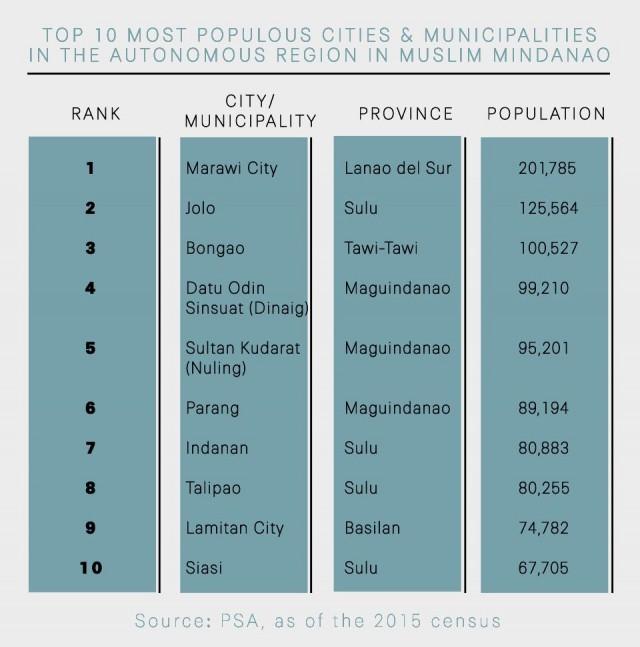
Marawi City’s 201,785 population as of the 2015 census is bigger than those of nine provinces—Batanes, Camiguin, Siquijor, Apayao, Dinagat Islands, Mountain Province, Biliran, Guimaras and Quirino, PSA data say.
Relatively young
Based on the latest available PSA data, two things stand out in Marawi City’s demographics. Marawi City population is relatively younger than the national average. Also, unlike national projections, there are more females than males in the city.
Based on the 2010 census, 41.54 percent or 4 in 10 of Marawi City residents are children under 15 years old. This is equivalent to 76,105 residents in 2010.
Nationwide, persons under 15 years old comprised 33.4 percent of the total household population in 2010. This means 30.7 million Filipinos were below 15 years of age in 2010.
The percentage of young people in the population of Marawi City is virtually the same as that in the 2000 census. There were 55,741 people aged 15 and below in 2000, or 42.31 percent of the population of Marawi City that time. This increased to 76,105 in 2010.
Professor Julkipli Wadi of the University of the Philippines Institute of Islamic Studies said the young population of Marawi City could be a result of the practice of Maranao parents leaving their children behind to work elsewhere.
“Maranao abled men and women usually venture in other parts of the country by engaging in various businesses particularly acting as vendors and entrepreneurs. As such they often leave their children to finish their studies in Marawi and other parts of Lanao. They prefer their children to study in Marawi so they are able to imbibe Maranao language, custom and tradition. Hence many Maranao children outpace the population growth of older Maranaws.” he said.
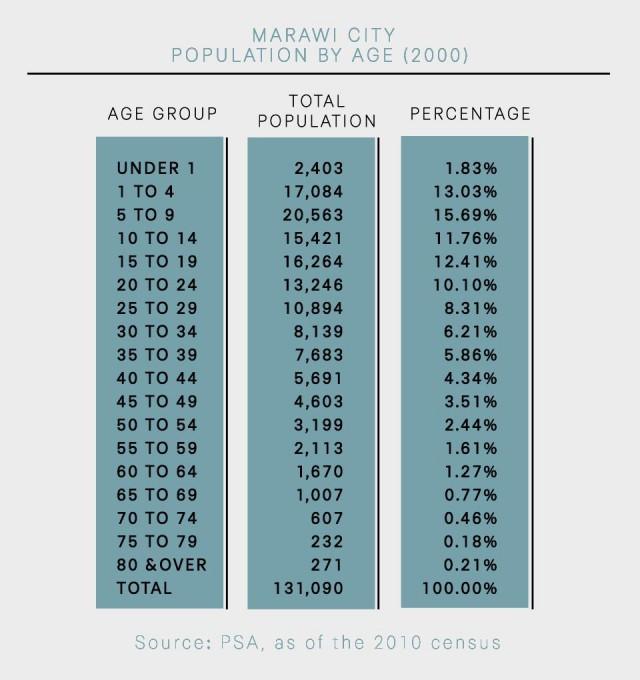
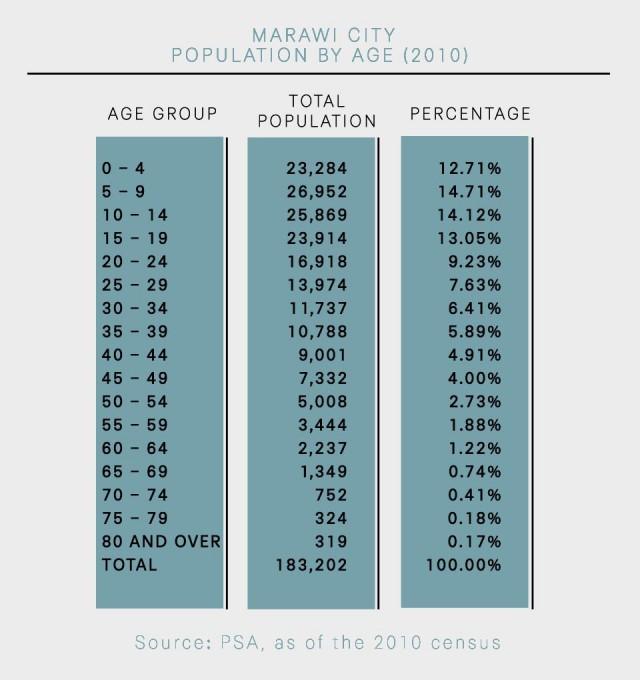
More females than males
In terms of distribution by sex, there were more females than males in Marawi City, data from the 2010 census indicate. Nationwide, there were more males than females in the country in 2010.
PSA data show that 51.36 percent of the population of Marawi City in 2010 are females, equivalent to 94,100 people. This was the same profile in 2000, when 51.86 percent or 67,980 of the city population were female, PSA data said.
Nationwide, PSA figures show the 50.4 percent of the Philippine population in 2010 were male while 49.6 percent were female.
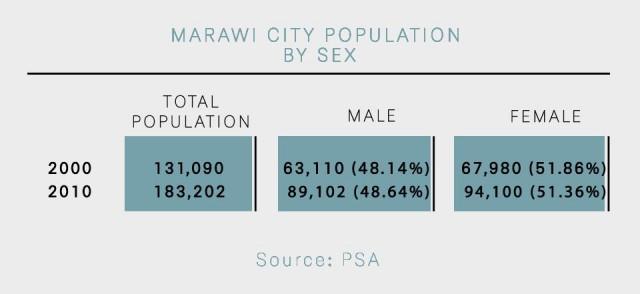
Mostly Maranao
A vast majority–96 percent—of the population of Marawi City in 2010 classified themselves as members of the Maranao ethnic group.
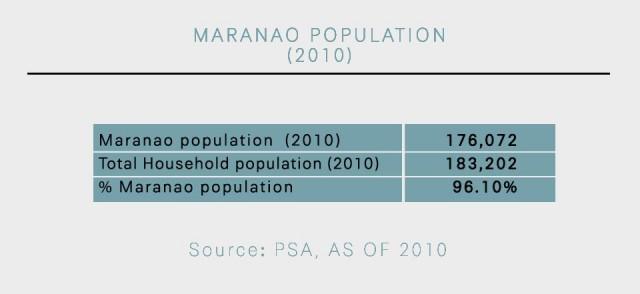
Wadi said the ongoing conflict in Marawi City may have sprung from the influence of Maranao ulama or Islamic scholars who studied in Arab countries.
“Marawi has for decades evolved a certain type of Islamic orthodoxy reflective of certain practices in some Arab countries due to the influx of Maranao ulama who graduated from the Middle East,” he said.
Wadi said the peace and order situation in Marawi may have driven Marawi residents Omar and Abdullah Maute to embrace ISIS ideology and sow terror in their city.
“If President Duterte’s source is true, that drug money drives the Maute, then Marawi must be ripe to the mix of factors that make radical groups like the Maute emerge… The group’s frustration on the peace process, (also make) them easy prey by the so-called ISIS ideology,” Wadi said. —NB, GMA News



